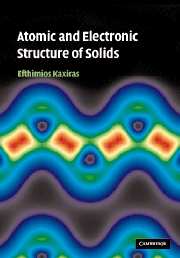Book contents
- Frontmatter
- Contents
- Preface
- Acknowledgments
- I Crystalline solids
- 1 Atomic structure of crystals
- 2 The single-particle approximation
- 3 Electrons in crystal potential
- 4 Band structure of crystals
- 5 Applications of band theory
- 6 Lattice vibrations
- 7 Magnetic behavior of solids
- 8 Superconductivity
- II Defects, non-crystalline solids and finite structures
- III Appendices
- References
- Index
1 - Atomic structure of crystals
Published online by Cambridge University Press: 06 July 2010
- Frontmatter
- Contents
- Preface
- Acknowledgments
- I Crystalline solids
- 1 Atomic structure of crystals
- 2 The single-particle approximation
- 3 Electrons in crystal potential
- 4 Band structure of crystals
- 5 Applications of band theory
- 6 Lattice vibrations
- 7 Magnetic behavior of solids
- 8 Superconductivity
- II Defects, non-crystalline solids and finite structures
- III Appendices
- References
- Index
Summary
Solids exhibit an extremely wide range of properties, which is what makes them so useful and indispensable to mankind. While our familiarity with many different types of solids makes this fact seem unimpressive, it is indeed extraordinary when we consider its origin. The origin of all the properties of solids is nothing more than the interaction between electrons in the outer shells of the atoms, the so called valence electrons. These electrons interact among themselves and with the nuclei of the constituent atoms. In this first chapter we will give a general description of these interactions and their relation to the structure and the properties of solids.
The extremely wide range of the properties of solids is surprising because most of them are made up from a relatively small subset of the elements in the Periodic Table: about 20 or 30 elements, out of more than 100 total, are encountered in most common solids. Moreover, most solids contain only very few of these elements, from one to half a dozen or so. Despite this relative simplicity in composition, solids exhibit a huge variety of properties over ranges that differ by many orders of magnitude. It is quite extraordinary that even among solids which are composed of single elements, physical properties can differ by many orders of magnitude.
One example is the ability of solids to conduct electricity, which is measured by their electrical resistivity. Some typical single-element metallic solids (such as Ag, Cu, Al), have room-temperature resistivities of 1–5μΩ·cm, while some metallic alloys (like nichrome) have resistivities of 102μΩ·cm. All these solids are considered good conductors of electrical current.
- Type
- Chapter
- Information
- Atomic and Electronic Structure of Solids , pp. 4 - 41Publisher: Cambridge University PressPrint publication year: 2003

